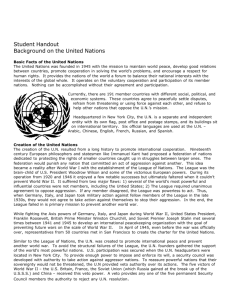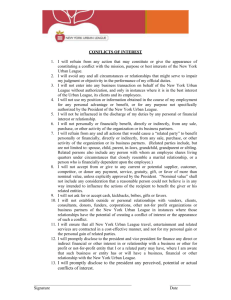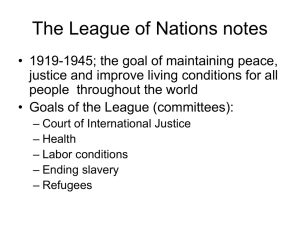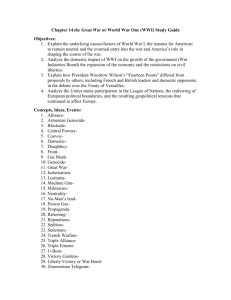League of Nations/United Nations
advertisement
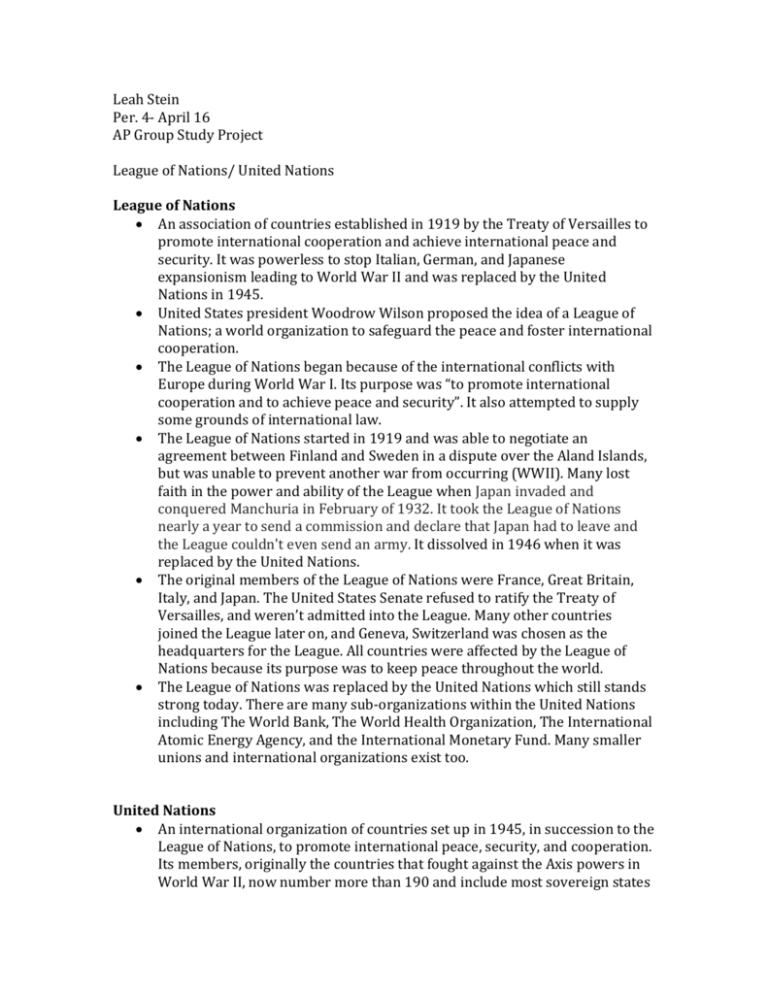
Leah Stein Per. 4- April 16 AP Group Study Project League of Nations/ United Nations League of Nations An association of countries established in 1919 by the Treaty of Versailles to promote international cooperation and achieve international peace and security. It was powerless to stop Italian, German, and Japanese expansionism leading to World War II and was replaced by the United Nations in 1945. United States president Woodrow Wilson proposed the idea of a League of Nations; a world organization to safeguard the peace and foster international cooperation. The League of Nations began because of the international conflicts with Europe during World War I. Its purpose was “to promote international cooperation and to achieve peace and security”. It also attempted to supply some grounds of international law. The League of Nations started in 1919 and was able to negotiate an agreement between Finland and Sweden in a dispute over the Aland Islands, but was unable to prevent another war from occurring (WWII). Many lost faith in the power and ability of the League when Japan invaded and conquered Manchuria in February of 1932. It took the League of Nations nearly a year to send a commission and declare that Japan had to leave and the League couldn't even send an army. It dissolved in 1946 when it was replaced by the United Nations. The original members of the League of Nations were France, Great Britain, Italy, and Japan. The United States Senate refused to ratify the Treaty of Versailles, and weren’t admitted into the League. Many other countries joined the League later on, and Geneva, Switzerland was chosen as the headquarters for the League. All countries were affected by the League of Nations because its purpose was to keep peace throughout the world. The League of Nations was replaced by the United Nations which still stands strong today. There are many sub-organizations within the United Nations including The World Bank, The World Health Organization, The International Atomic Energy Agency, and the International Monetary Fund. Many smaller unions and international organizations exist too. United Nations An international organization of countries set up in 1945, in succession to the League of Nations, to promote international peace, security, and cooperation. Its members, originally the countries that fought against the Axis powers in World War II, now number more than 190 and include most sovereign states of the world. The term "United Nations" was first coined in 1942 by United States president, Franklin D. Roosevelt, in the Declaration by United Nations. This declaration was made to officially state the cooperation of the Allies (Great Britain, the United States, and the Union of Soviet Socialists Republic) and other nations during World War II. The UN was not officially founded until 1945 when the Charter of the United Nations was drafted at the UN Conference on International Organization in San Francisco, California. The conference was attended by 50 nations and several non-governmental organizations - all of which signed the Charter. The UN officially came into existence on October 24, 1945 after ratification of the Charter. The United Nations began because the League of Nations failed in preventing World War II from occurring. The United Nations was created to act as a better, more affective international organization than the League of Nations was. Representatives from the United States, China, Great Britain, the Soviet Union, and France finalized the majority of the Charter’s provisions in 1944, before WWII was even over. The final version solidified in San Fransico in 1945. Through the years, and still today, the United Nations has kept peace, prevented wars, protected human rights, and has provided humanitarian assistance around the world. The United States, China, Great Britain, The Soviet Union, and France were the original members of the United Nations. Today, 193 out of the 196 countries in the world are members of the United Nations. The United Nations continuously helps all countries around the world in whatever ways possible. The United Nations is still going strong today and has many suborganizations within it, including: The World Bank, The World Health Organization, The International Atomic Energy Agency, and the International Monetary Fund. Many smaller unions and international organizations exist too.





